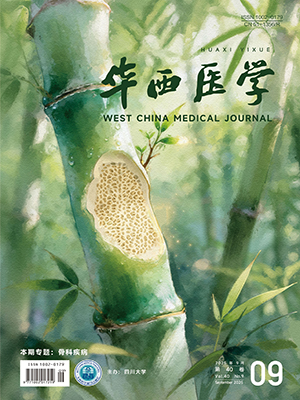| 1. |
Li Z, Yuan T. Neutrophil extracellular traps in adult diseases and neonatal bacterial infectious diseases: a review. Heliyon, 2023, 10(1): e23559.
|
| 2. |
王彩云, 许红梅, 刘钢, 等. 2019-2020 年 160 例儿童肺炎链球菌脑膜炎临床流行病学多中心研究. 中国当代儿科杂志, 2024, 26(2): 131-138.
|
| 3. |
Garcia PCR, Barcelos ALM, Tonial CT, et al. Accuracy of cerebrospinal fluid ferritin for purulent meningitis. Arch Dis Child, 2021, 106(3): 286-289.
|
| 4. |
Cheng X, Zhang Q, Fu Z, et al. Establishment of a predictive model for purulent meningitis in preterm infants. Transl Pediatr, 2022, 11(6): 1018-1027.
|
| 5. |
于海明, 王德兴, 刘晓萌, 等. 血清 PTX3、copeptin 联合测定对重症肺炎儿童预后的预测价值探讨. 河北医科大学学报, 2023, 44(3): 300-304.
|
| 6. |
Sabry A, Ibrahim M, Khashana A. Assessment of pentraxin 3 in a systemic inflammatory response occurring with neonatal bacterial infection. J Neonatal Perinatal Med, 2021, 14(4): 563-568.
|
| 7. |
Loacker L, Egger A, Fux V, et al. Serum sPD-L1 levels are elevated in patients with viral diseases, bacterial sepsis or in patients with impaired renal function compared to healthy blood donors. Clin Chem Lab Med, 2023, 61(12): 2248-2255.
|
| 8. |
邵肖梅, 叶鸿瑁, 丘小汕. 实用新生儿学. 北京: 人民卫生出版社, 2019: 307-375.
|
| 9. |
何疏梅, 赵晓芬, 和灿林, 等. 新生儿难治性化脓性脑膜炎临床特点及高危因素分析. 中国医药导报, 2022, 19(24): 93-97.
|
| 10. |
梁琰, 郭大川, 刘玉莹, 等. 病毒性脑炎及化脓性脑膜炎患儿血清血管内皮细胞钙黏蛋白降钙素原的变化及意义. 中国实用神经疾病杂志, 2020, 23(12): 1072-1076.
|
| 11. |
韦茹, 张悦, 马杰, 等. 脐血 25-羟基维生素 D 水平与 6 个月龄婴儿神经发育的关系. 实用医学杂志, 2020, 36(14): 1913-1918.
|
| 12. |
兰敏, 周慧霞. 血清降钙素原在鉴别小儿不典型化脓性脑膜炎和病毒性脑炎中的作用. 实用临床医药杂志, 2020, 24(9): 37-39.
|
| 13. |
赵晓芬, 杨米凤, 郝婷婷, 等. 脑脊液 TNF-α和 IFN-γ检测在新生儿化脓性脑膜炎诊断中的意义. 检验医学与临床, 2023, 20(14): 2045-2047, 2052.
|
| 14. |
Chen Y, Yin Z, Gong X, et al. A sequential guide to identify neonates with low bacterial meningitis risk: a multicenter study. Ann Clin Transl Neurol, 2021, 8(5): 1132-1140.
|
| 15. |
Sarkarinejad A, Paydar S, Khosrojerdi A, et al. Copeptin: a novel prognostic biomarker in trauma: a review article. J Health Popul Nutr, 2023, 42(1): 128.
|
| 16. |
Pichler A, Kurz A, Eichlseder M, et al. Perloperative inflammatory response assessment in high-risk patients undergoing non-cardiac surgery (INSIGHT): study protocol of a prospective non-interventional observational study. BMJ Open, 2023, 13(7): e065469.
|
| 17. |
Hammad R, Elshafei A, Khidr EG, et al. Copeptin: a neuroendocrine biomarker of COVID-19 severity. Biomark Med, 2022, 16(8): 589-597.
|
| 18. |
Massimino AM, Colella FE, Bottazzi B, et al. Structural insights into the biological functions of the long pentraxin PTX3. Front Immunol, 2023, 14: 1274634.
|
| 19. |
Thomsen MM, Munthe-Fog L, Trier Petersen P, et al. Pentraxin 3 in the cerebrospinal fluid during central nervous system infections: a retrospective cohort study. PLoS One, 2023, 18(3): e0282004.
|
| 20. |
Chen L, Liu S, Adah D, et al. Soluble programmed death ligand-1-induced immunosuppressive effects on chimeric antigen receptor-natural killer cells targeting glypican-3 in hepatocellular carcinoma. Immunology, 2023, 169(2): 204-218.
|
| 21. |
Morrell ED, Bhatraju PK, Sathe NA, et al. Chemokines, soluble PD-L1, and immune cell hyporesponsiveness are distinct features of SARS-CoV-2 critical illness. Am J Physiol Lung Cell Mol Physiol, 2022, 323(1): L14-L26.
|
| 22. |
Xuan Hoan N, Thi Minh Huyen P, Dinh Tung B, et al. Association of PD-L1 gene polymorphisms and circulating sPD-L1 levels with HBV infection susceptibility and related liver disease progression. Gene, 2022, 806: 145935.
|
| 23. |
刘巧美, 周进芳, 宫莉. 472 例儿童化脓性脑膜炎预后不良因素分析. 安徽医学, 2020, 41(11): 1340-1343.
|




